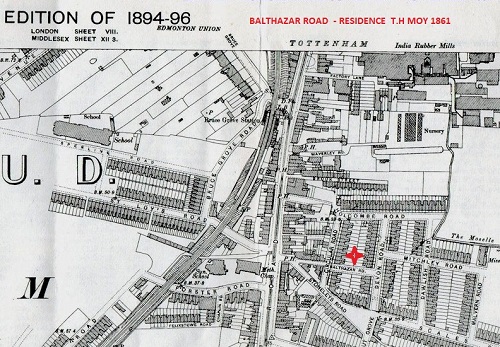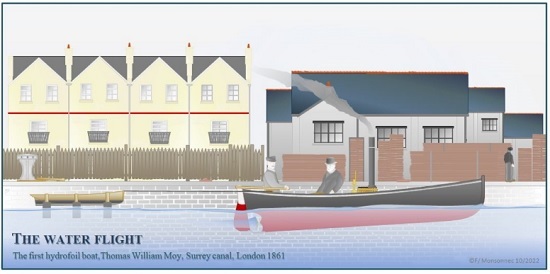
DRAWING: FREDERIC MONSONNEC
(from original research by Frederic Monsonnec)
 DRAWING: FREDERIC MONSONNEC |
THOMAS WILLIAM
MOY (1822-1905) AERONAUTICAL PIONEER (from original research by Frederic Monsonnec) |
|
INTRODUCTION I have recently received information on a most
fascinating man who features in Tottenham’s Hidden History.
Surprisingly, I was contacted by man who lives in the west of France, in
the city of Lorient. I suspect that, just like myself, most people will
never have heard of Thomas William Moy and yet he features as one of
Britain’s early pioneers in the field of both aeronautics and maritime
engineering. I am indebted to the help provided by Frederic Monsonnec and for his wonderful drawings. The drawings were produced by Frederic and are based on his research about Thomas Moy’s life and inventions. |
 |
I was informed that in 1861 Thomas W Moy
was living in Balthazar Road, Tottenham, that I was to discover was once
the road on which the Beehive Pub had stood before the Stoneleigh South
bombings in 1940. The road was totally destroyed and of course we now
know the area as Holcombe Road. Thomas W Moy was listed as a Boarder, and his occupation shown as being an Engineer and Naval Architect. It is suspected that his wife and children were perhaps abroad in Europe at the time of the Census. |
|
At the later 1871 Census he was living at 3
Church Road Terrace in the All Hallows parish. He is now joined by his
wife Henrietta, who is Prussian by birth, along with 8 of their
children. For the purists amongst you, due to a transcription error, his
name was digitised ’May’ instead of Moy. At this time, he gave his
occupations as ‘Law Stationer’, although he still pursued his interest
in aeronautics and maritime engineering.
Thomas Moy's introduction to aeronautics had been through ballooning but
he soon became interested in heavier-than-air flight and performed some
experiments with lifting and towing
surfaces by
towing a model craft on the Surrey canal in 1861.
Moy was one of the earliest members of the Aeronautical Society of Great
Britain (later the Royal Aeronautical Society) and presented several
papers at its meetings, including one in 1869 describing the soaring
flight of albatrosses in a wind.
|
|
 CHURCH ROAD -TOTTENHAM (PHOTOGRAPH COURTESY - PETER THOMAS) |
 1871 CENSUS - THOMAS WILLIAM MOY & FAMILY -3 CHURCH ROAD TERRACE TOTTENHAM |
| In the context of his research into aeronautics, Thomas Moy had the idea of using water to study the aerodynamics of wings by observing the underwater eddies they created. This took place in 1861, at the time he was living in Tottenham. He used a two-foot-long model equipped with three broad wings to conduct his tests. The models were towed by a steam-launch on the Surrey canal and also the River Lea in Tottenham. During the tests he discovered there was less strain on the tow line as the speed increased and the model appeared to skim the water and raised the boat out of the water. It could be said that he had unintentionally invented the Hydrofoil. | |
 |
 |
LOST OPPORTUNITIES
Although the perceived invention of the hydrofoil by Thomas Moy was
involuntary, there were later developments by the Reverend Ramus, John
Thornicroft or William Froude who developed "Polysphenics"
boats (stepped hulls). The term means
‘The Possibility of a Greatly Increased Speed at Sea’.
Despite his progress, Thomas Moy was determined to keep his works
secret. He rarely mentioned his work with others and even destroyed some
of his models. In addition, some of his tests were poorly documented.
Consequently, many of his ideas remained in draft form. He did however
file 14 patents and later in life he was to become a Patent Agent.
|
|
 |
|
|
His best-known work, the Aerial
Steamer was constructed in 1874 and
tested at the Crystal Palace in South London in July 1875, with limited
success: aviation historians credit the machine with a brief flight,
lifting off the ground by 6 inches. The aircraft never came close to
fully flying because it was unable to reach the speed necessary for
takeoff. The society described it as "one of the most determined
attempts at solving the problem [of powered flight] which has yet taken
place."
It had been announced in Spring 1875 as being the first unmanned
airplane to fly from level ground, by Thomas Moy of England. The craft,
a tandem wing with two 12ft six-blade pusher paddles was powered by a
3hp steam engine. In 1879 Thomas Moy demonstrated the Military Kite to a meeting of the Aeronautical Society. This was a rubber-powered model, capable of taking off under its own power. |
|
 |
 |
|
SCREW PROPULSION
Thomas Moy had also taken an interest in Screw Propulsion which was later to replace paddle wheels as used on paddle-steamers. It is also possible that he may have recognized the concept of flight skirting above the water. The Hovercraft as we know it was not fully developed until the late 1950’s |
 SCREW PROPULSION TEST - PADDLES vs. PROPELLORS |
| OTHER RESEARCH INTERESTS Thomas Moy had been involved with many other experiments and, although not always at the forefront, he contributed towards research on other important topics that have stood the test of time and still feature heavily in aeronautical design and marine engineering today. |
||
| BULKHEADS | WIND TUNNELS - FRANCIS HERBERT WENHAM | |
 |
 |
|
| Thomas Moy was registered as a Naval Architect with the Institute of Naval Architects (Now RINA) and he regularly presented the results of his experiments and research. It was in 1873 that Thomas Moy presented the importance of equipping boats with numerous watertight bulkheads so, that in the event of fire or leaks, the volume or space between the bulkheads can be contained to fight fire or leaks and help prevent a more serious disaster. He emphasised that these bulkheads should extend right up to the upper decks. These proposals were presented almost 40 years before the tragic sinking of the ‘Titanic’ in 1912. It transpires that the ’Titanic’ was equipped with fifteen watertight bulkheads, some of which stopped before the Upper Deck, thus allowing these compartments to be flooded by water ingress at levels beneath the upper deck. |
It was in 1874 that Thomas Moy carried out tests in the very first ‘Wind
Tunnel’ that had been invented by F.H Wenham. The results exceeded Moy’s
expectations and helped demonstrate that the Lift/Drag ratio is more
advantageous at small angles of incidence as opposed to ratios of a
steeper inclination. Several years later in 1878, the Aeronautical Society acknowledged the contribution made by Thomas W Moy and his assistant R.C Jay, and verified the accuracy of data they had obtained alongside Francis Wenham some six years earlier. |
|
| LONDON FOOTPRINTS OF THOMAS WILLIAM MOY TOTTENHAM - RIVER LEA - CAMBERWELL - SURREY CANAL - CRYSTAL PALACE MAP BY FREDERIC MONSONNEC |
 |
|
OBITUARY: THE AERONAUTICAL JOURNAL - JANUARY
1905 |
|
We regret to announce the death of Mr. Thomas Moy, one of the early adherents of the Aeronautical Society of Great Britain, who breathed his last on December 2nd, at the advanced age of 85. Mr. Thomas Moy was throughout his life, a keen student of aeronautics, especially of what related to the attempts to navigate the air by a body heavier than air. In the early reports of the Society his name appears frequently in the discussions. Only three years ago he experimented on a wing machine which ran on a wooden railway. |
| CONCLUSION |
| It is amazing how this little-known man, who
lived for a while in Tottenham, was peripherally involved with many
aspects of flight and maritime engineering, yet his achievements were
overshadowed as he was often pipped-at-the-post by others who were to
receive worldwide recognition. His work on the Aerial Steamer was
performed 25 years before the Wright Brothers made the first manned
flight. |
| LATER RECOGNITION OF THOMAS WILLIAM MOY'S CONTRIBUTION TO AERONAUTICAL SCIENCE |
|
A
WHIRLWIND TRIP THROUGH PRE-PLANE FLIGHT -
06 January 2019
The idea of mechanical power flight certainly was not new with the
Wright Brothers. There had been many attempts made by others before the
Wrights even thought of building their first gliders.
Another Englishman, Thomas Moy and his assistant, R. E. Shill built
their full-scale "aerial steamer" in 1875, a contraption powered by a
three-horsepower steam engine and twin,
|
| NOTE: This is just an Overview of Thomas Moy's achievements - We are indebted to Frederic Monsonnec who has shared with us his extensive research notes that have been gained over several years. In addition he has given his permission for us to use his splendid drawings to help illustrate many of Thomas Moy's inventions and discoveries. |
Article prepared by Alan Swain Feb 2023 - All research notes and illustrations by Frederic Monsonnec